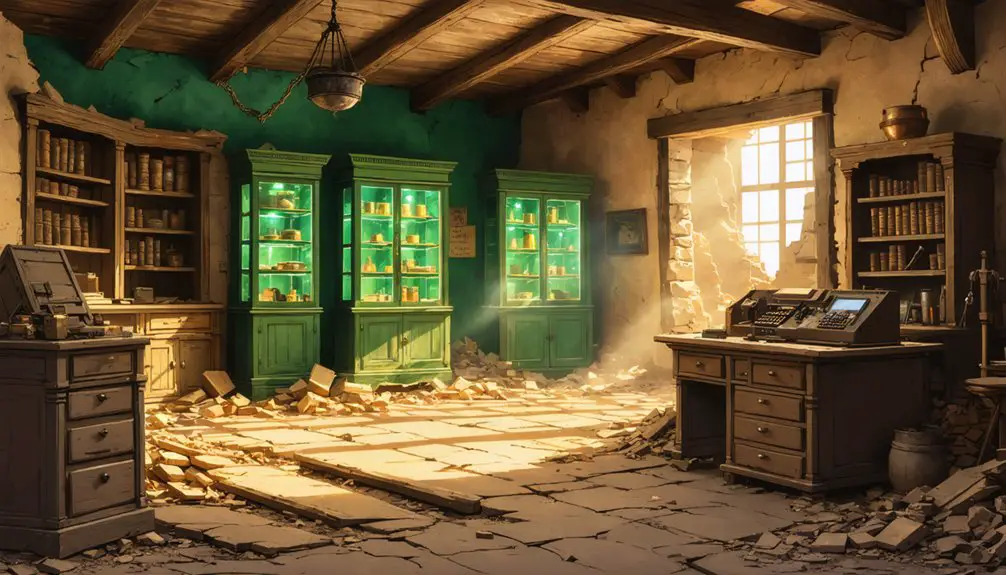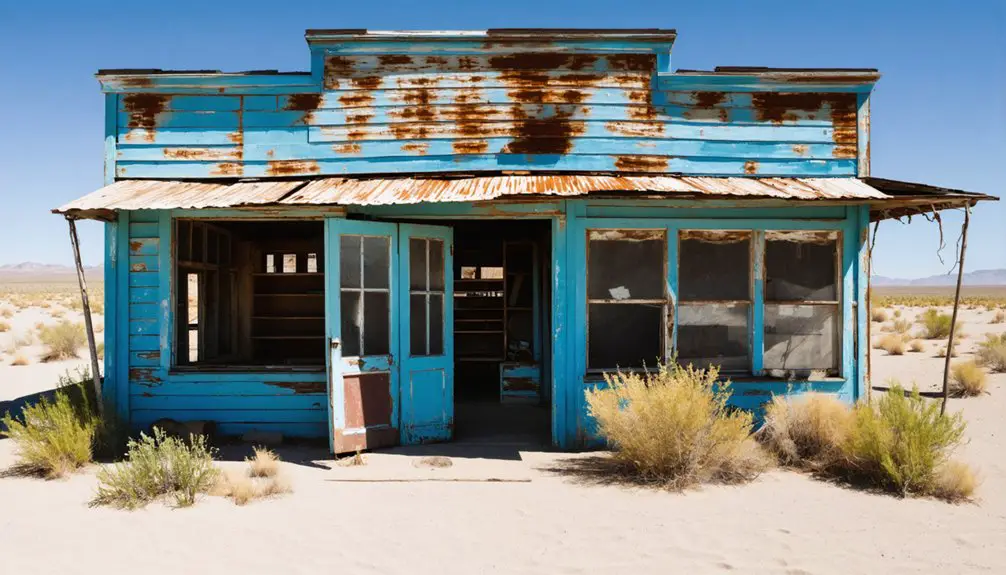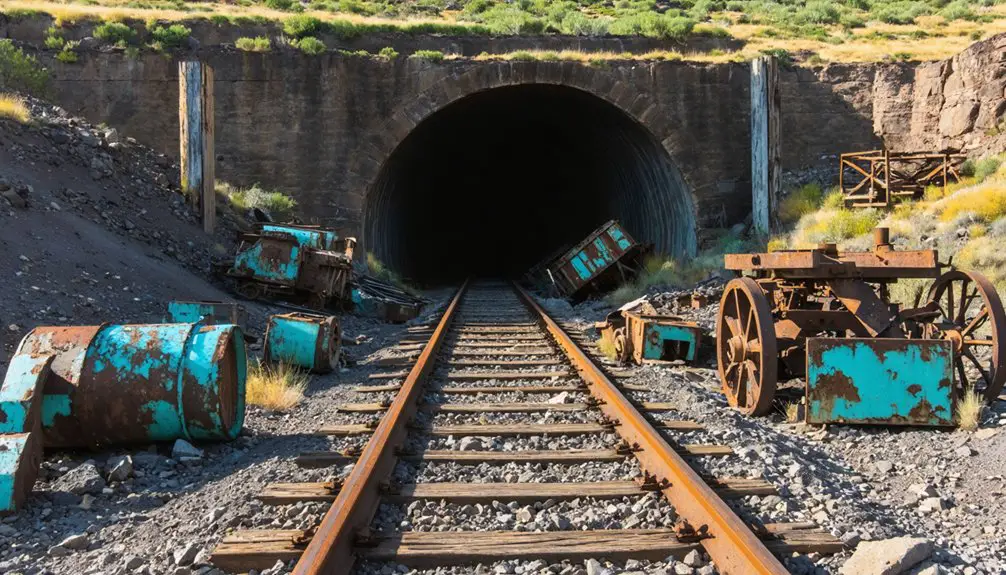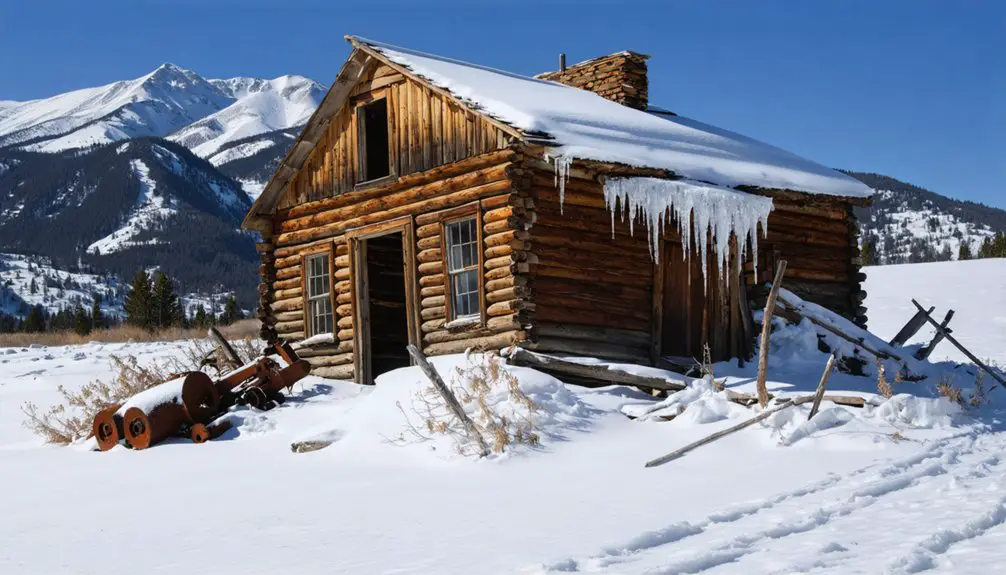You’ll find only earthen mounds marking the site of Ajax, Utah, where Welsh pioneer William Ajax built an innovative 11,000-square-foot underground department store in 1869. The store flourished until 1914, featuring skylights, cedar timber supports, and an earthen roof that moderated temperatures. Once valued at $75,000, the store’s inventory served Rush Valley communities and included extensive livestock facilities. This remarkable piece of frontier ingenuity holds deeper secrets beneath its dusty surface.
Key Takeaways
- Ajax was a thriving Welsh pioneer settlement in Rush Valley, Utah, centered around William Ajax’s innovative underground department store built in 1869.
- The underground store spanned 11,000 square feet with skylights and timber supports, offering goods valued at $75,000 during its peak.
- The settlement included extensive livestock facilities, accommodating 100 horses, 300 cattle, and 6,000 sheep, plus an above-ground hotel.
- Ajax declined after William Ajax’s death in 1899, with the store closing in 1914 due to competition and changing economic conditions.
- Today, only dirt mounds mark the location of the former underground store, which was destroyed by fire after serving as a hobo shelter.
A Welsh Pioneer’s Vision in Rush Valley
The pioneering spirit of Welsh immigrants transformed Rush Valley in the mid-1800s, as they brought their deep mining expertise from their homeland to Utah’s untapped mineral wealth.
You’ll find their immigrant resilience reflected in the settlements they established, particularly in communities like Wales, where they maintained strong ties to their Welsh heritage while adapting to frontier life.
Under the leadership of Dan Jones, these skilled miners scouted promising sites and developed essential mining operations in the Sanpitch Mountain foothills. The Udgorn Seion magazine helped unite Welsh converts and preserve their cultural bonds.
Led by Dan Jones, Welsh miners used their expertise to establish crucial mining operations throughout Utah’s Sanpitch foothills.
They recreated familiar social structures from their homeland, establishing tight-knit communities that balanced preservation of their customs with integration into the broader Utah society.
Their technical knowledge proved invaluable to Mormon leaders, who sought to build a self-sustaining economy through mining development.
The harsh working conditions they faced in Industrial Revolution Wales had prepared them well for the challenges of establishing new mining communities in Utah’s rugged terrain.
The Underground Marvel: Ajax’s Unique Department Store
Deep beneath Rush Valley’s desert soil, an extraordinary retail establishment took shape in 1869 when Welsh immigrant William Ajax began excavating what would become an 11,000-square-foot underground department store.
This marvel of underground architecture featured cedar timber supports, south-facing skylights, and an earthen roof that protected shoppers from Utah’s harsh climate extremes. The store was constructed using only a shovel and wheelbarrow as equipment. Much like Ajax the missionary who transformed communities through religious conversion in 466 AD, William Ajax’s innovative store would become a transformative force in the region.
- You’d find everything from frontier necessities to imported luxuries, with inventory valued at $75,000.
- The store’s innovative two-story design included a café and connected to an above-ground hotel.
- Cedar beams supported the expansive 80′ x 100′ retail space.
- Natural lighting flooded the subterranean shop floor through strategic skylighting.
This retail innovation served as the heart of commerce for neighboring communities, drawing visitors from Mercur, Stockton, and Ophir until its closure in 1914.
Life and Commerce in Early Ajax Settlement
You’ll find the roots of Ajax’s commerce in its 1863 Welsh farming settlers, who first cultivated hay and raised livestock in the fertile valley between Stockton and Vernon.
William Ajax’s arrival in 1869 transformed the settlement’s trading prospects when he established his department store, initially selling goods from his kitchen shelf before expanding into a dedicated building with an integrated post office. Similar to web page updates, the store adapted quickly to changing community needs.
The store quickly became the heart of Ajax’s rural community, serving as both an essential trading post for miners and farmers and a social hub where residents gathered to exchange news and conduct business. To combat the region’s extreme temperatures, Ajax constructed an innovative underground business area that included a department store, café, and hotel.
Welsh Settlers’ Early Days
While pioneers across Utah Territory sought promising locations for settlement, Welsh farmers established the community of Centre in 1863, choosing the area for its strategic position between Stockton and Vernon in Rush Valley.
These resilient immigrants brought their cultural traditions and agricultural practices from Wales, adapting them to Utah’s harsh frontier environment. You’ll find their ingenuity reflected in their building choices, including adobe structures and underground spaces that helped moderate extreme temperatures. William Ajax demonstrated this innovative spirit when he built the Big Store Underground, which served as the settlement’s main commercial center.
- Settlers maintained traditional hay cultivation and livestock raising methods
- Daily routines balanced Welsh farming expertise with frontier adaptations
- The community’s shared heritage strengthened social bonds and resilience
- Their agricultural skills proved essential during the region’s 1860s mining boom
Commerce Around Ajax Store
In 1869, William Ajax transformed the commercial landscape of Rush Valley by constructing an innovative underground store that would become one of Utah Territory’s most remarkable retail establishments.
You’d find the 11,000-square-foot subterranean marvel protecting shoppers from harsh desert elements while offering an impressive $75,000 inventory of goods.
The store’s economic significance reached far beyond basic frontier supplies. It stocked fine imported tableware, cut crystal, and elegant textiles that drew customers from Mercur, Stockton, and Ophir. Like many directed colonies of the era, the settlement’s organization and development received guidance from church leaders. Jim Bridger’s scouts frequently visited the store while guiding travelers through the territory.
The merchant community dynamics centered around this commercial hub, which included extensive livestock facilities handling 100 horses, 300 cattle, and 6,000 sheep.
The “Big Store” even outperformed Salt Lake City emporiums, serving as an essential stopover for travelers and establishing Ajax as a pivotal node in regional trade networks.
Rural Trading Hub Life
The early settlement of Ajax emerged from humble beginnings in 1863 when Welsh farmers established what they first called Centre, aptly named for its location between Stockton and Vernon in Rush Valley.
Rural commerce thrived as the community’s resilience grew through shared resources and trading opportunities with passing miners and travelers.
- You’d find families operating from dugouts and adobe homes that doubled as trading posts.
- Deep community wells, some over 400 feet, served as significant gathering points for multiple families.
- William Ajax’s innovative underground structure provided temperature-controlled commerce space.
- The post office, established by 1870, became a critical hub for communication and social exchange.
Life centered around these trading points where you’d witness the exchange of hay, livestock, and essential supplies, forming the backbone of Ajax’s rural economy. Much like Ajax Motors Co., the town demonstrated remarkable innovation in establishing local industry and commerce.
William Ajax: The Merchant Who Built a Town

Pioneer merchant William Ajax carved his legacy into Utah’s landscape when he emigrated from Wales in 1862 and settled in Rush Valley. As a converted Mormon and former worker for the Welsh LDS paper Udgorn, he brought his entrepreneurial spirit to the American frontier.
Ajax’s impact on the region grew exponentially when he built his innovative underground store in 1870. Using only basic tools, he created an 11,000-square-foot subterranean department store, complete with south-facing skylights and timber supports from local mountains.
His merchant legacy flourished as the store became a crucial hub, stocking $75,000 worth of goods and serving mining camps, ranchers, and neighboring communities. The settlement, nicknamed Ajax, supported facilities for thousands of livestock and shaped the region’s commerce until the store’s closure in 1914.
The Slow Fade of a Frontier Trading Post
While Ajax’s underground store flourished during the frontier era, post-World War II economic shifts dramatically altered the trading post landscape across Utah.
You’d have witnessed the trading post decline as returning veterans embraced the cash economy, while improved roads made distant towns more accessible.
Like many frontier community hubs, Ajax’s trading post couldn’t compete with modern retail options.
You’ll find that these changes reflected a broader pattern across Utah’s trading posts:
- Veterans returning from WWII preferred urban shopping centers over traditional posts
- Improved roads and increased vehicle ownership reduced reliance on local traders
- Modern franchise stores offered greater variety and convenience
- Traditional posts, built from sandstone and adobe, struggled to modernize
The once-bustling Ajax trading post eventually succumbed to these pressures, marking the end of an era.
From Bustling Store to Desert Depression

If you’d visited Ajax’s underground store in its heyday, you would’ve found Welsh immigrant William Ajax’s innovative trading post carved into solid bedrock, serving miners and ranchers throughout Rush Valley.
The store’s golden era ended with Ajax’s death in 1899, after which his sons struggled to maintain the business amid railway competition and the devastating closure of nearby Mercur in 1913.
Today, all that’s left of this once-bustling commercial hub is a depression in the Utah desert, marked by a historical sign and the ashes of its final chapter as a hobo shelter that burned in the 1920s.
Underground Store’s Trading Era
During its heyday from 1870 to the early 1900s, the Ajax Underground Store flourished as one of Utah Territory‘s most remarkable retail establishments, boasting an inventory worth over $70,000 in period currency.
You’d find sophisticated trading practices that rivaled Salt Lake City’s finest emporiums, with merchant strategies focused on serving miners, ranchers, and travelers from Mercur, Stockton, and Ophir.
- Full-service departments offered everything from essential foods to imported fine textiles
- Extensive stables accommodated 100 horses, 300 cattle, and 6,000 sheep for visiting traders
- On-site hotel and café provided comfortable lodging for weary travelers
- Local hay harvesting operations supplied vital feed to regional mining and ranching operations
The store’s unique underground construction protected shoppers from harsh desert conditions while creating an inviting marketplace that became the region’s primary trading hub.
Welsh Immigrant’s Bold Vision
Behind the remarkable success of the Ajax Underground Store stood William Ajax, a determined Welsh immigrant whose journey from South Wales to Utah Territory embodied the pioneering spirit of the American West. Born to unmarried parents in 1832, he’d forge his path through immigrant entrepreneurship after converting to the Mormon faith and serving as a missionary for nearly a decade.
You’ll find Ajax’s cultural resilience reflected in his evolution from failed shopkeeper to successful merchant. After his initial Salt Lake City store collapsed, he didn’t give up. Instead, he moved to Rush Valley, started selling hay to mines, and gradually built a commercial empire from a two-room adobe house.
Abandoned Store’s Final Days
Fate dealt a crushing blow to the Ajax Underground Store when the arrival of nearby railroad lines in the late 1800s redirected commerce away from Rush Valley.
You’d have witnessed the store’s decline accelerate after William Ajax’s death in 1899, as his sons struggled against mounting competition from mail-order catalogs and dwindling local populations. The once-bustling underground marketplace, valued at over $70,000 in merchandise, couldn’t survive the economic shifts.
- Above-ground structures were dismantled and moved away by 1914
- The underground portion remained embedded in the hillside
- It became a makeshift hobo shelter during the 1920s
- A fire started by transients eventually destroyed what remained
Today, you’ll find only a depression in the earth and a historical marker where this remarkable underground enterprise once served Rush Valley’s miners and ranchers.
Preserving the Memory of Ajax’s Underground Legacy

Preservation efforts to document Ajax’s remarkable underground legacy face unique challenges, as only dirt mounds now mark where William Ajax’s innovative 11,000-square-foot subterranean store once stood.
Despite its physical absence, the store’s heritage preservation remains essential to understanding Utah’s frontier commerce and engineering ingenuity.
You’ll find the story of Ajax woven into the fabric of Rush Valley’s history, where this pioneering underground marketplace once served as the region’s economic lifeline.
The store’s historical significance extends beyond retail – it was a symbol of frontier adaptability, using local cedar timbers and innovative skylights to create a comfortable trading space in harsh desert conditions.
While the physical structure is lost, Ajax’s legacy lives on through historical records documenting its role as a crucial hub for miners, ranchers, and travelers.
Frequently Asked Questions
What Other Welsh Settlements Existed Near Ajax During Its Peak Years?
You’ll find Wales (formerly Coalbed) was the main Welsh settlement near Ajax, reflecting Welsh heritage and settlement patterns through mining activities, while smaller Welsh enclaves dotted Tooele and Carbon counties.
How Deep Was the Underground Store Built Into the Ground?
You’ll find this remarkable piece of underground architecture extended 10-15 feet deep initially, reaching up to 20 feet below ground in some areas during ghost town exploration of its two-story layout.
What Specific Products Were Most Commonly Sold at Ajax’s Store?
You’d find staples like food provisions and general merchandise dominated sales, while mining supplies, tools, hardware, and fine imported goods met the daily needs of frontier families and miners.
Did Any Other Buildings in Ajax Use Underground Construction Methods?
You won’t find other examples of underground architecture in Ajax besides William Ajax’s store. While mining techniques created tunnels below ground, commercial and residential buildings stayed above ground level.
What Happened to William Ajax’s Descendants After the Store Closed?
You’ll find the Ajax descendants faced harsh realities after 1914 – they’d lost their livelihood and left their isolated town behind. Their lasting legacy lives through historical markers they helped establish.
References
- https://en.wikipedia.org/wiki/Ajax
- https://dbpedia.org/page/Ajax
- https://www.wikiwand.com/en/map/Ajax
- https://onlineutah.us/ajaxhistory.shtml
- https://kids.kiddle.co/Ajax
- https://stories.utahhumanities.org/stories/items/show/295
- https://historytogo.utah.gov/dan-jones/
- https://en.wikipedia.org/wiki/Welsh_Americans
- https://www.uen.org/utah_history_encyclopedia/m/MINING.shtml
- https://heritage.uen.org/resources/Wc48ee1385df71.shtml



